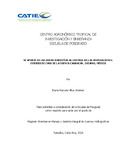| dc.contributor.advisor | Imbach, Alejandro, M.Sc | es_Es |
| dc.contributor.author | Ulloa Jiménez, Diana M. | es_ES |
| dc.date.accessioned | 2015-07-24T16:30:39Z | |
| dc.date.available | 2015-07-24T16:30:39Z | |
| dc.date.issued | 2014 | |
| dc.identifier.uri | https://repositorio.catie.ac.cr/handle/11554/7131 | |
| dc.description | Tesis (Mag Sc.) -- CATIE, 2014 | es_ES |
| dc.description.abstract | Para medir el aporte de las zonas ribereñas al control de las inundaciones se requiere de un análisis general del contexto de una cuenca inundable. El funcionamiento de la cuenca se analizó usando el modelo SWAT que considera el clima, la hidrología, temperatura, características del suelo, pesticidas, nutrientes, Crecimiento de las plantas y manejo del suelo. Para examinar los diferentes componentes del ciclo hidrológico relacionados con las inundaciones, las características de la cuenca y los ecosistemas presentes se analizaron varios eventos de inundación registrados desde 1965. El proceso de modelación permite definir subcuencas con altos rendimientos de agua y caudales durante los eventos de inundación. La calibración ayudó a corregir algunos parámetros que permitían obtener información más adecuada de los caudales altos y de esta manera mejorar el modelo inicial. Después de obtener el modelo calibrado se cambiaron los usos de suelo presentes en la cuenca para incorporar las zonas ribereñas con diferentes anchos alrededor de los cauces, en sitios con pendientes menores a 20%. Los resultados de estas simulaciones permitieron definir los cambios generados en el caudal de la cuenca, las subcuencas y el rendimiento de agua. El resultado final indicó que los procesos de inundación permanecen porque no existieron grandes cambios en los caudales ni en el rendimiento de agua con los escenarios mencionados. | es_ES |
| dc.description.abstract | To measure the contribution of riparian zones to floods control it is required an overall analysis of the context in a flood basin. To understand the functioning of the watershed we used a SWAT model that considers climate, hydrology, temperature, soil characteristics, pesticides, nutrients, plant growth and soil management practices. To understand the different components of the hydrological cycle related to floods, the watershed characteristics and the present ecosystems, various flood events registered since 1965 had to be analyzed.
The modeling process allows us to define subbasins with high water yields and flows during the flood events. The calibration process helped to correct certain parameters to obtain more suitable information for high flow and thereby improve the initial model. After obtaining the calibrated model the land uses in the watershed were changed to incorporate riparian zones with different widths around the channels, in sites with slopes less than 20%. The results of these simulations permitted defining the changes generated in the flow of the basin, sub-basins and water yield. The final results indicated that the flooding processes remain because there was not a big change in the flow out or the water yield with the scenarios mentioned. | en_EN |
| dc.language.iso | es | es_ES |
| dc.publisher | CATIE, Turrialba (Costa Rica) | es_ES |
| dc.relation.ispartof | Maestría en Manejo y Gestión en Cuencas Hidrográficas | |
| dc.subject | CUENCAS HIDROGRAFICAS | |
| dc.subject | INUNDACIONES | |
| dc.subject | CONTROL DE INUNDACIONES | |
| dc.subject | ORGANIZACION DE AGUAS | |
| dc.subject | CICLO HIDROLOGICO | |
| dc.subject | MODELOS DE SIMULACION | |
| dc.subject | MODELIZACION DEL MEDIO AMBIENTE | |
| dc.subject | CALIBRACION | |
| dc.subject | ECOSISTEMA | |
| dc.subject | MEXICO | |
| dc.title | El aporte de las zonas ribereñas al control de las inundaciones: estudio de caso de la cuenca Cahoacán, Chiapas, México | es_ES |
| dc.type | Tesis de maestría | es_ES |
| dcterms.rights | acceso abierto | |
| dc.identifier.publisher | CATIE | es_ES |
| dc.identifier.publication | CATIE | es_ES |


